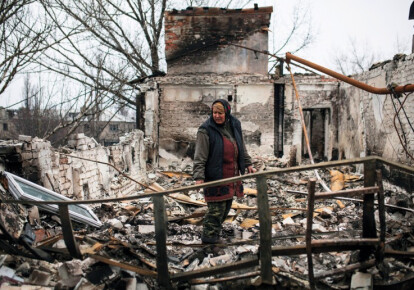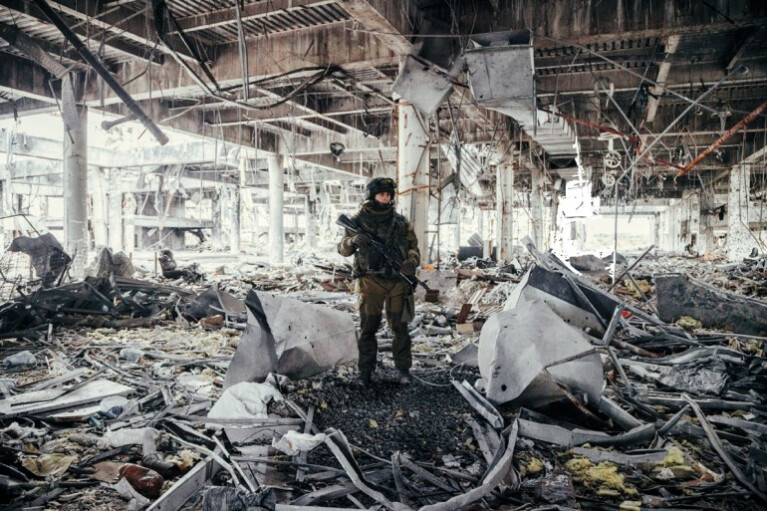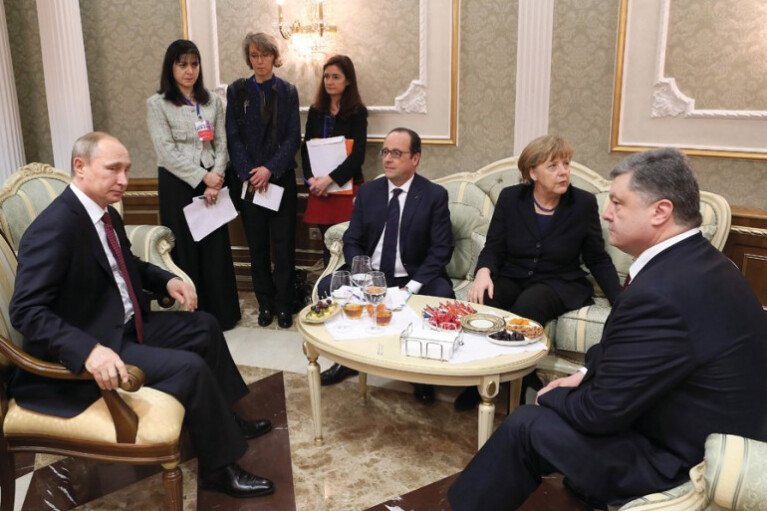What Ukraine, Russia and the West lost due to the 5-year conflict in the Donbas

The way the GDP of Ukraine and the Russian Federation dropped
The volume of economic losses of Ukraine due to the Russian aggression was outlined on March 25, 2018 by Petro Poroshenko, then the sitting President of Ukraine. "Due to the annexation of the Crimea, Ukraine lost 3.6% of the GDP, 80% of its oil and gas deposits in the Black Sea, and 10% of its port infrastructure. Due to the occupation of part of the Donbas, we lost 15% of the GDP, 25% of the industry, and almost a quarter of commodity exports. About 100 mines remain in the occupied territory as well as bank assets in the amount of about USD 5 billion. This is what we've lost during the war as a result of hostilities", President said. He added: "However, thanks to the Association Agreement with the EU, we found an alternative to the Russian market. Exports to the EU countries and to other international partners of ours are growing by tens of percent."
In addition to direct losses, there are also indirect ones: in particular, due to breakdown of economic ties with enterprises in the Russian Federation and in the Ukrainian territories that turned to be under the Russian occupation, as well as due to deep financial crisis that plagued Ukraine, Hryvnia depreciation, drop of income and purchasing power of the Ukrainians and other similar factors.
The overall economic losses of Ukraine are evidenced by the IMF's estimates of ukraine's GDP dynamics in dollar terms. These data are provided in the table; there are also similar data on GDP of the Russian Federation for comparison.
In 2013, the last pre-war year, ukraine's GDP amounted to USD 180 billion. The loss of 18.6% of GDP, which Poroshenko mentioned (3.6% due to the Crimea annexation and 15% due to the occupation of the Donbas part), means an annual loss of USD 33.4 billion, of which USD 6.5 billion are allocated to the Crimea and USD 26.9 billion are allocated to the Donbas.
However, the table shows that during the first two war years, ukraine's GDP has halved - from USD 180 billion in 2013 to USD 90 billion in 2015. That is taking into account all losses, direct and indirect ones in 2015 Ukraine has lost USD 90 billion, and not USD 33.4 billion. In subsequent years, the total annual economic losses of Ukraine gradually decreased, but still exceeded USD 33.4 billion. In particular, in 2018 ukraine's GDP was lagging behind the pre-war level by USD 55 billion, according to the IMF estimates.
The table also shows that for Russia the total amount of annual economic losses, taken as a share of the pre-war GDP, turned out to be almost the same as for Ukraine. In fact, ukraine's GDP in 2015 was USD 90 billion in 2016 - USD 93 billion, which made 50% і 52% of year 2013 respectively. At the same time, russia's GDP in 2015 was USD 1.364 billion in 2016 - USD 1.283 billion, making 60% і 56% of year 2013 respectively.
Крім того, the IMF builds forecasts of worse GDP dynamics in Russia over the next five years compared to Ukraine. According to the IMF, in 2018 russia's GDP reached USD 1,631 billion, or 71% of year 2013, while ukraine's GDP was USD 125 billion, or 69% of year 2013. And in 2024, according to the IMF, russia's GDP will amount to USD 1,921 billion, or only 84% of year 2013, while ukraine's GDP to be USD 207 billion, or 115% of year 2013. This means that the economic burden of the hybrid war (including losses from the Western sanctions) turned out to be even more substantial for Russia than for Ukraine.
Window of opportunities for the USA
Of course, the West suffers losses from this war as well. However, with regard to the USA, it can be assumed that its losses are very insignificant compared to the GDP and, in addition, they are compensated by much greater bonuses. In particular, the USA has been actively pushing Russia out of the European gas natural market by putting in place tanker supplies of the liquefied natural gas (LNG).
The process was ініціював by the European Commission President Jean-Claude Juncker and the USA President Donald Trump on July 25, 2018. In their joint statement, they expressed their readiness to continue strengthening of the trade relations for the benefit of all American and European citizens. Exactly one year later, on July 25, 2019, the European Commission reported: "Since July 2018, the EU has significantly increased LNG imports from the USA - by over 367%. So far, in 2019, one third of all LNG exported from the USA has gone to the EU. The USA is the third largest LNG supplier to the EU, while the EU has become a major export destination for American LNG."
On this the occasion EC President Juncker said: "the EU stands to what has been agreed with the President Trump on that day last year. We want a win-win trading situation, beneficial for both the EU and the USA. Having one of the most important economic relationships in the world we want to continue trade strengthening between us based on the last July positive spirit." Therefore, it can be expected that the displacement of the Russian gas by the American one will continue in the EU market.
Changes in trade among Ukraine, Russia and the EU
The situation with the economic losses of the European Union is more complicated. Yet, Russia is one of its largest trading partners. Therefore, it makes sense to consider the overall picture of the goods trade dynamics in the Ukraine-Russia-EU triangle.
Russia is the largest exporter in this triangle. According to the Eurostat and the State Statistics Service of Ukraine, in 2013 the Russian exports of goods to 28 EU countries amounted up to Euro 207 billion and its exports to Ukraine made Euro 17.5 billion. The Western Ukrainian and sanctions due to the Russian aggression against Ukraine have led to narrowing of the Russian export opportunities. During 2014-2018, Russia exported goods to the EU by EUR 283.9 billion less and to Ukraine - by EUR 53.3 billion less compared to the level of goods deliveries maintained annually as of year 2013. Russia's total losses amounted to EUR 337.2 billion. This equals about to 5% of russia's total GDP over these five years (in other words, Russia has been losing about 5% of its GDP annually due to narrowing of exports to the EU and Ukraine).
In their turn the EU countries exported to Russia goods for the amount of EUR 119.4 billion and to Ukraine - for EUR 23.9 billion in 2013. In subsequent years, supplies to both Russia (due to the war of sanctions) and Ukraine (due to the drop of the Ukrainian economy) decreased. During 2014-2018, the EU exported goods to Russia by EUR 176.4 billion less, and to Ukraine - by EUR 29.6 billion less compared to the level of goods deliveries maintained annually as of year 2013. The total EU losses amounted to EUR 206 billion. This equals to less than 0.3% of total EU GDP over these five years.
Finally, in 2013, Ukraine exported goods worth EUR 11.3 billion to Russia and EUR 13.9 billion to the EU. In subsequent years, there was a reduction in deliveries to Russia, which was partially compensated by an increase in supplies to the EU (starting in 2017) thanks to the Association Agreement. During 2014-2018, Ukraine exported goods worth EUR 35.1 billion less to Russia and EUR 5.1 billion more to the EU compared to the level of goods deliveries maintained annually as of year 2013. Therefore, ukraine's uncompensated losses amounted to EUR 30 billion. This equals about to 6.4% of ukraine's total GDP over these five years.
Thus, losses from export cuts were almost as painful for the Ukrainian economy as for ukraine's. Meanwhile, losses from export reductions were 20 times less painful for the EU than for Russia Ukraine or.
The question of price affordability
Considering how all these losses affect the further situation in the Donbas, it should be considered that in addition to the issue of price there is also the issue of its affordability. The same price may be acceptable to one society - and totally unacceptable to another.
In particular, the European politicians find it necessary to respond to export losses, even if such losses make only a few tenths of GDP percent. Thus, a kind of paradoxical picture is observed. The EU neighbouring countries with the Russian Federation, i.e. Finland, Estonia, Latvia, Lithuania, Poland, are most affected by the decline in exports to Russia, but namely these countries are least likely to the demand lifting of sanctions against Russia. At the same time, economies in some where the reduction of exports to the Russian Federation is barely noticeable, such as Italy, Germany, France, Greece, Austria, Hungary, the idea of sanctions lifting is popular with the politicians.
The paradox solution is that citizens of the EU neighbouring countries with Russia tend to consider Russia as a source of danger; they fear that their countries may become the next (after Ukraine) victims of the Russian aggression, and therefore regard the economic losses from anti-Russian sanctions as an affordable price. Therefore, the leading political forces in these countries stick to the same standpoint. But the citizens of other EU countries may demonstrate their selfish considerations: why do we have to quarrel with Russians for the sake of the Ukrainians and bear losses?
Therefore, we should be aware that any weakening of Kyiv's standpoint may increase the popularity in the EU of the idea of sanctions lifting. And surely the EU will never be a bigger supporter of sanctions than Ukraine itself.
Of course, for Ukraine the price of war is not narrowed to economic losses, although they are very high. With no money to measure the price of human loss. On May 6, 2019, Petro Poroshenko reported that during the aggression of the Russian Federation against Ukraine in the Donbas, 2,973 Ukrainian service persons had been killed. According to the Office of the United Nations High Commissioner for Human Rights, the death toll in eastern Ukraine reached 13,000, of which 3,300 were civilians; and the number of wounded made 30,000.
In addition, the Ukrainian invasion means for Ukraine not only the loss of businesses and other assets, but also a humanitarian disaster. According to the Ministry of Social Policy of Ukraine, as of July 22, 2019 more than 1 million 393 thousand displaced persons from the temporarily occupied territories of Donetsk and Luhansk regions and the Crimea have been registered. Let this number be overestimated at the expense of so-called "pension tourists", but in any case, hundreds of thousands of Ukrainian citizens have left their homes, and several millions have been forced to live under the Russian occupation.
The Kremlin is trying to force Kyiv to pay yet another price: to recognize Donetsk and Luhansk as parties to the conflict, that is, to admit that this is a conflict civil war, and not the Russian aggression. It is important to realize that taking the blame of someone else (Russia) would mean for Ukraine an institutional and cultural disaster with drastic consequences for Ukrainian statehood and national consciousness.
At the same time, the question of price affordability is not a question for the Ukrainian society since it (the Ukrainian society) accepts any price (economic losses, the Ukrainian troops and volunteers killed and wounded in the Donbas) which Putin is ready to pay. But one should understand that Putin himself now seeks drastically to reduce the price being paid by Russia by shifting it to Ukraine. If Ukraine withstands pressure of the Kremlin and does not agree to its terms, then Putin will have to negotiate with Ukraine and the West the other options of price reduction. For Ukraine this will mean a forced compromise, but, at any rate, not a capitulation.
Read more:



